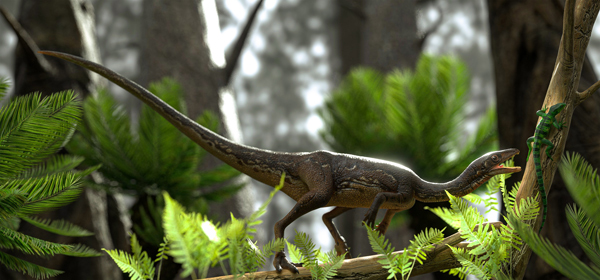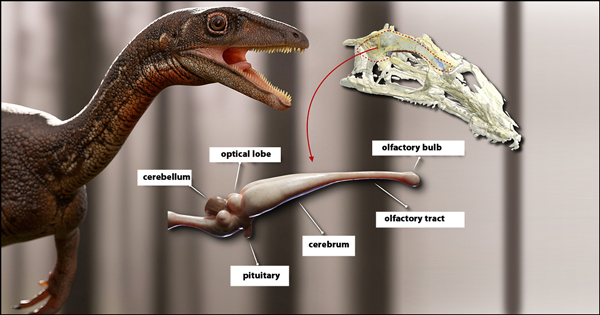Research Maps the Brain of an Early Dinosaur
Buriolestes schultzi – A Relatively “Smart” Sauropodomorph
The huge sauropods such as Apatosaurus, Brachiosaurus, Mamenchisaurus and Brontosaurus are not regarded as particularly clever animals. Their brains were extremely small when compared to their huge body sizes, therefore any consideration of a “smart” sauropod is greatly undermined by their miniscule encephalisation quotient (ratio of brain size to body size). However, this lineage of lizard-hipped dinosaurs survived for over a 130 million years and they were extremely successful being both speciose and geographically widespread.
A newly published paper provides an insight into the evolutionary development of the brains of these types of dinosaurs. Writing in the academic “Journal of Anatomy” scientists report upon the study of the near perfectly preserved neurocranium of Buriolestes schultzi, a member of the Sauropodomorpha known from the Carnian faunal stage of the Late Triassic of Brazil. The researchers conclude that although the brain of this emu-sized dinosaur was very small, it probably had acute vision and fast reactions – very useful when you are actively pursuing prey.
A Life Reconstruction of the Triassic Sauropodomorph Buriolestes schultzi

Picture credit: Márcio L. Castro
A Well-developed Flocculus of the Cerebellum
Buriolestes roamed what is now the Rio Grande do Sul region of southern Brazil around 233 million years ago. It was a lightweight, bipedal, omnivorous dinosaur part of a group whose descendants would evolve into the giant sauropods of the Jurassic and Cretaceous. Researchers from the Federal University of Santa Maria in collaboration with colleagues from the Universidade de São Paulo (both institutions in Brazil), used computerised tomography to create a three-dimensional landscape of the inside of the skull of a fossil specimen in order to map the various regions of the brain.
They discovered that Buriolestes had a well-developed flocculus region of its cerebellum, a part of the brain linked to motor skills and co-ordination. The analysis also revealed an elongated olfactory tract (related to sense of smell), combined to a relatively small pituitary gland, but the area of the brain associated with processing information from the eyes was much more sophisticated. The researchers inferred that the eyes were essential in the pursuit of prey, that vision was the dominant sense of Buriolestes.
Mapping the Brain of a Late Triassic Sauropodomorph (B. schultzi)

Picture credit: Márcio L. Castro
The Senses of Buriolestes
Commenting on the research, one of the co-authors of the paper, palaeontologist Mario Bronzati (Universidade de São Paulo), stated:
“The dinosaur [Buriolestes] had a faunivorous diet. Unlike a carnivore, which is restricted to eating meat from other animals, the faunivore also includes the ingestion of insects and other small invertebrate animals. This characteristic, as well as its size, makes the species quite different from the most famous representatives of its lineage, the sauropod giants and herbivores which were the largest animals ever to walk the Earth.”
The team concluded that the characteristics of the brains of these types of dinosaurs changed dramatically as they evolved an entirely herbivorous diet and developed huge body sizes. Whilst Buriolestes was an agile, swift hunter the later sauropods evolved brains more suited to their particular niche in dinosaur dominated terrestrial communities.
Jurassic sauropods such as Brontosaurus and Diplodocus had higher olfactory capabilities when compared to Buriolestes. This more developed sense of smell is believed to play a role in foraging, helping plant-eaters to discriminate between digestible and indigestible vegetation. Having a better sense of smell may also have been important in the later sauropods if they were social animals living in herds. For example, higher olfactory capabilities are associated with vertebrates with more complex social behaviours, it is important for these herding animals to be able to detect and track chemical secretions.
First Calculations of the Reptile Encephalization Quotient (REQ) for a Triassic Dinosaur
As well as providing information on how the brains sauropodomorphs evolved and changed over time, the researchers were able to plot the Reptile Encephalisation Quotient (REQ) for Buriolestes, the first time this has been calculated for a Triassic dinosaur. The Reptile Encephalisation Quotient essentially correlates an animal’s physical characteristics with perceived intelligence, it provides an estimate of how “smart” an animal might be.
Time‐calibrated Reptile Encephalisation Quotient (REQ; 50%) of Selected Saurischians

Picture credit: Müller et al (Journal of Anatomy)
The scientists found that B. schultzi had a REQ lower than most Jurassic theropod dinosaurs, but much higher than that of later, much larger sauropodomorphs. Although, the lack of fossils to study prevents the researchers from comparing the REQ of Buriolestes with contemporaneous animals, the team do suggest that when Jurassic sauropods are considered, it could be that encephalisation tended to decline in this dinosaur lineage.
To read an early article (2016) about Buriolestes by Everything Dinosaur: When Did the Dinosaurs Dominate the Land?
The scientific paper: “The endocranial anatomy of Buriolestes schultzi (Dinosauria: Saurischia) and the early evolution of brain tissues in sauropodomorph dinosaurs” by Rodrigo T. Müller, José D. Ferreira, Flávio A. Pretto, Mario Bronzati and Leonardo Kerber published in the Journal of Anatomy.
The Everything Dinosaur website: Everything Dinosaur.

